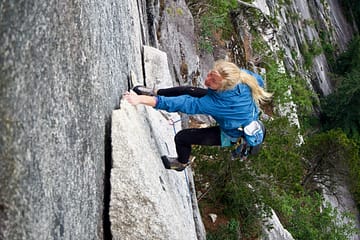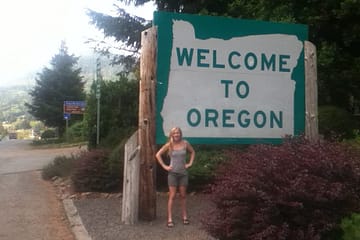August 13th, 2018
The very first time I saw the Big Show, that famous 38-degree overhanging wall, I was squatted on the grey uneven rocks deep inside the well of an internal auditory memory from August 8th, 2010. I felt like I was being ripped into scraps of fabric and stuffed down a drain only to clog the pipe and be beat with a plunger.
I pulled into the parking lot minutes after a young woman had fallen about 12m to the blocky, rocky ground. After a few minutes, she began to scream. Her wails of agony washed over my body and my heartbeat quickened. People who had seen her up close or had talked to medical professionals on the scene said optimistic words. Unlike them, I felt no hope, only a solid certainty. “I don’t need to hear this, she smells like death.”
I walked down the trail, away from the familiar noise, unsure if it was reverberating inside my skull or if more than one woman had fallen. A few feet past the first turn in the trail I stopped mid-step.
Another two, three steps. My eyes close. I squat, hands to face, draw a steady breath. Stand again. A few more steps. Walk again, slowly, across grey rocks, lichen, an odd concrete platform. Squat. Cover my face with my hands and breath in jagged, sobbing breaths. Stand. Inhale through the nose. Purse the lips. Send a train of air through the tunnel of the mouth. In one, two, three. Out. Walk. Heart rate rises, skipping, choking. Left. Right foot. Toes up. Tighten trunk, lift legs. Ears ring. The silent hum crescendos. Enveloped. Ribcage frozen. Fixed draws, backpacks, climbers, distractions. Hide? No, it is here; face the circling cries of anguish, burnt flesh, knees on asphalt. Squat. Tears, face twisted, folded body. Pause. Salt on the tongue. Surrender. One. Two. Three. Expand the ribcage one inch. Yield.
“Are you okay?”
“It’s so loud. I can hear them burning.”
The pattern of gasoline combusted, the echo of the thud. The smooth stick shift in the palm. The click of the door handle. The round belly of the man in the median. Flames exploding from her chest. Collapsed like a ragdoll, marionette. A corpse in the road, the van driving towards her. Shrill cries, surrounding from all sides. Bare skin on the hospital floor. Bloodspots dropped off the bedrails. Wheels of a stretcher and the whir of a helicopter. Silver tweezers part calloused foot-flesh. White gauze. A mattress in the grass, an empty sky full of stars. Wooden fence. Echoing moans. Screams wrapping around me, sinking into me. The aural representation of a body wracked with pain until it ceases to pump blood or draw air encircling me and anchoring me fast into the dirt beneath these kind strangers’ gentle backyard. Sensation. Sound. Sight. Grey stones, bolts, kind strangers.
Worn through Evolv Cruzers. Maybe that’s enough, is it time to climb out of the well? To surrender is so simple, it feels so good to wallow. Wir können nur vorne. We can only go forwards. This is your last round of sobs. Palm wet with tears and snot. Have you breathed recently? Return, release. In through the mouth, purse the lips, eject. Can you take your heart out of your ears?
“Breathe, honey. What’s your name?”
“I’m okay.”
In 2010, I witnessed three people burn to their death on Hwy 395 near Bishop. It was a visual, auditory, and emotional experience. I came away unscathed compared to the others in the accident. Five people died and two more lost limbs, spending the next years in rehab facilities struggling to regrow skin. Others had brain injuries and broken bones. Most of the victims were between 17 and 20, two separate cross country teams and myself. The driver at fault, a 17-year old driving her teammates and running coach, burned alive in her seat. My healing process has been arduous, but physically I had it easy.
Overcoming the mental trauma has been a bigger challenge than regrowing skin. At first, it was helpful for me to recount the story, to tell the absurd tale of why my left arm was bandaged to my chest. I described events, but never my internal emotional response. By sharing my experience, I admitted my pain to myself. I avoided action-adventure films, walked out when the memory of screams resurfaced amid a silent college classroom, and arranged car trips so as always to be in the driver’s seat. Since about 2014, I’ve made a concerted effort to face these challenging activities because I want to be able enjoy movies and nap in the passenger’s seat. For movies, I’ve been able to push back creeping flashbacks by leaning on friends and breathing steadily. The scenes roll forward and so do I.
The day before the flashback in Cheakamus, I was discussing the interview in The Sun Magazine with Bruce Perry, “The Long Shadow: The Lingering Effects of Childhood Trauma.” One paragraph stood out to me: “When a child with a typical equilibrium is traumatized, he is aware of the change and can report his distress to others. But when a child grows up in an environment permeated with chaos or violence, that child perceives this state of hypervigilance and distractibility as the norm. If asked whether he feels anxious, he will say no. We can tell how anxious he is by the way he startles when he hears a sudden noise, by his inability to sit still, and so forth. But to him this is normal. This is his baseline.”
The interview inspired a conversation with a friend on the couch of Zephyr about confronting emotional distress rather than avoiding it. My goal is to overcome this in the long term, to have fewer and fewer flashbacks. If I can face the flashback rather than push it back, perhaps I can help my mind better understand the nuanced difference between a healthy normal and operating in an underlying stressed state of hypervigilance. By recognizing when my current state is abnormal, then I can also become aware that changes should be made, that I should deploy some coping and overcoming strategies. Face the flashback. Live the pain again, confront it, not avoid it. Write about it, fight with it, care about it, cry over it, dream it, scream it, breathe it, release it, forgive it.
Physical locations, odors, colors, sounds, all connect with memory. Returning to Chek was my way of facing a challenging memory head-on. Trying Freewill, though I was out of shape from two months off climbing, was exhilarating, literally painful, and gave me something to come back for at this unique wall.
I wanted to be sure not to form a connection between distress and climbing in general and torment and this sport crag specifically. Here’s where the woman made those noises; I am here and I am okay. Here’s where I fell down the well and climbed back out. I am here, my heart beats in my chest. I see you, despair, we can visit from time to time. Anguish, you will be at most a nuisance and you will not have a long life within me.


